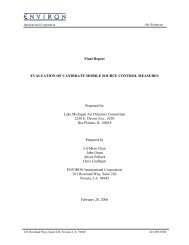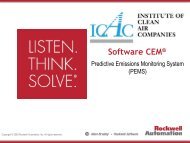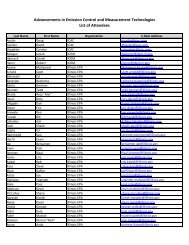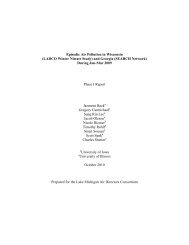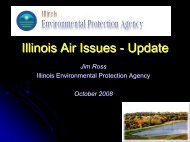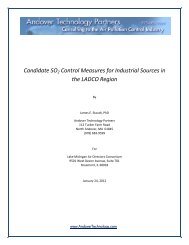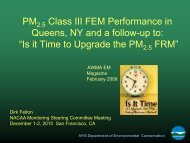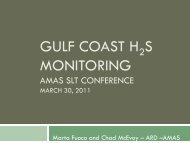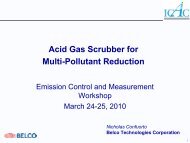An Introduction to Drafts MOVES 2009 - ladco
An Introduction to Drafts MOVES 2009 - ladco
An Introduction to Drafts MOVES 2009 - ladco
You also want an ePaper? Increase the reach of your titles
YUMPU automatically turns print PDFs into web optimized ePapers that Google loves.
<strong>An</strong> <strong>Introduction</strong> <strong>to</strong> Draft<br />
<strong>MOVES</strong><strong>2009</strong><br />
MTAQS<br />
Oc<strong>to</strong>ber 27, <strong>2009</strong><br />
Gary Dolce<br />
EPA Office of Transportation and Air Quality
Outline<br />
• <strong>MOVES</strong> overview<br />
– What is Draft <strong>MOVES</strong><strong>2009</strong><br />
– Comparison <strong>to</strong> MOBILE6.2<br />
• How does <strong>MOVES</strong> work<br />
• Making the transition <strong>to</strong> <strong>MOVES</strong><br />
• <strong>MOVES</strong> demonstration – Jeff Houk, FHWA<br />
2
<strong>MOVES</strong><br />
• MO<strong>to</strong>r Vehicle Emission Simula<strong>to</strong>r<br />
• State-of-the-art modeling framework<br />
• Will replace current models (MOBILE & NONROAD)<br />
and expand capabilities<br />
• Designed <strong>to</strong> allow easier incorporation of large<br />
amounts of in-use data from a variety of sources<br />
– MOBILE structure limited ability <strong>to</strong> incorporate new emissions<br />
data<br />
3
Improvements in <strong>MOVES</strong> compared<br />
<strong>to</strong> MOBILE<br />
• Graphical User Interface (GUI)<br />
• Data elements easy <strong>to</strong> modify/update<br />
• Both g/mi and <strong>to</strong>tal inven<strong>to</strong>ry output<br />
• Output easy <strong>to</strong> cus<strong>to</strong>mize<br />
• Multiple scales – National, County, Project<br />
• Emission rates calculated on modal basis<br />
• Designed from the ground up as an energy<br />
consumption model for GHG estimation<br />
• New data, new emission processes, updated<br />
vehicle and fuel standards<br />
4
How Do Emissions<br />
Estimates of Draft<br />
<strong>MOVES</strong><strong>2009</strong> Compare <strong>to</strong><br />
MOBILE6.2
Early Draft <strong>MOVES</strong> Results<br />
• Data collected since MOBILE6 released drives differences<br />
between <strong>MOVES</strong> and MOBILE6<br />
• National trends<br />
– HC and CO emissions similar or lower than MOBILE6.2<br />
– Total NOx emissions higher than MOBILE6.2<br />
– Total PM emissions substantially higher than MOBILE6.2<br />
• Local results may vary<br />
– Local fleet mix, fuels, activity are important<br />
– Temperature drives PM emissions<br />
• For attainment analysis, relative change in emissions<br />
between base year and attainment year is more important<br />
than absolute emissions<br />
6
Why are emissions different<br />
• New car and light truck emissions data<br />
• New heavy truck emissions data<br />
• New emissions processes not included in<br />
MOBILE6<br />
• Updated fuel and vehicle standards<br />
7
Significant new data in <strong>MOVES</strong><br />
• Updated emission rates<br />
– Test results on millions of vehicles considered for <strong>MOVES</strong><br />
• Passenger Cars & Trucks<br />
• Heavy Duty Trucks<br />
• New fleet & activity defaults<br />
– National defaults:<br />
• Vehicle fleet from state registration data, VIUS<br />
• Vehicle Miles Traveled (VMT) from HPMS<br />
• Driving patterns from instrumented vehicle surveys<br />
– For local modeling, local data is likely <strong>to</strong> be most accurate &<br />
up-<strong>to</strong>-date<br />
8
Extensive analysis of Car & Light<br />
Truck emissions<br />
• HC/CO/NOx rates based on ~ 70,000 vehicles<br />
randomly selected from Arizona IM program<br />
– Able <strong>to</strong> tease out emissions from I/M and non I/M areas<br />
• Checked against data from multiple sources<br />
– I/M data from Illinois, New York, Missouri and Colorado<br />
– Roadside remote sensing data from several cities<br />
– Kansas City Study<br />
• Extended <strong>to</strong> newest technology vehicles using<br />
compliance data<br />
– In-use emissions data manufacturers required <strong>to</strong> collect<br />
– About 2,000 labora<strong>to</strong>ry tests per year<br />
9
Gasoline PM a major focus<br />
• Landmark study conducted in Kansas City 2004-05<br />
<strong>to</strong> address need for improved gas PM estimates<br />
– Collaboration between EPA, DOE, DOT, States, Au<strong>to</strong>/Oils<br />
• 496 gasoline light-duty cars and trucks tested<br />
– Model Years 1968-2005<br />
• Summer and winter testing<br />
– ~ half of the vehicles tested each season @ ambient temps<br />
– 43 vehicles tested in both winter and summer<br />
• More information at<br />
http://www.epa.gov/otaq/emission-fac<strong>to</strong>rs-research/<br />
10
What we’ve learned about Car &<br />
Light Truck emissions<br />
• New standards have been successful in reducing<br />
deterioration of HC/CO/NOx emissions<br />
• On-Board Diagnostic (OBD) systems are a<br />
contributing fac<strong>to</strong>r <strong>to</strong> lower deterioration<br />
– Owner response <strong>to</strong> repair identified malfunctions is better than<br />
MOBILE6 projected, particularly in non-I/M areas<br />
• Gas PM emissions are much higher than MOBILE6<br />
projected<br />
– Higher in-use deterioration<br />
– Significant increase at cold temperatures<br />
11
Arizona I/M NOx data by Model Year and Age<br />
Flattening trend<br />
drop in deterioration with<br />
Tier 1s<br />
12
Heavy Duty Diesel emissions<br />
updated based on real world data<br />
• MOBILE6 relied on certification data<br />
– Engine tests only<br />
• Much research on in-use trucks since MOBILE6<br />
– CRC E-55<br />
• 75 trucks on chassis dynamometer<br />
• Only real-time PM data of it’s kind<br />
– On-Board Measurement: ~350 trucks on road<br />
• Provided most robust assessment of NOx emissions available<br />
• Extended idle, crankcase, starts, tampering & malmaintenance<br />
fac<strong>to</strong>red in (not in MOBILE6)<br />
13
What we’ve learned about Heavy<br />
Duty Diesel emissions<br />
• NOx<br />
• PM<br />
– In-use emissions moderately higher than MOBILE6 projected<br />
– Extended idle (hoteling) emissions are significant<br />
• <strong>An</strong>d projected <strong>to</strong> grow as percent of NOx inven<strong>to</strong>ry<br />
– Significant speed effect<br />
• MOBILE6 did not model any speed impacts<br />
• Large increase in emissions at lower speeds vs. MOBILE6<br />
– Crankcase emissions significant<br />
14
<strong>An</strong>alysis of Local Area Impacts<br />
• Did preliminary comparison of <strong>MOVES</strong> and<br />
MOBILE6 using surrogate local data <strong>to</strong> represent 3<br />
different urban counties<br />
– Local data very limited, may not be consistent with what states<br />
will actually use<br />
• Local data varied by:<br />
– Fleet age distribution<br />
– Fraction of light and heavy duty VMT<br />
– Local fuel specifications<br />
– Meteorology<br />
– Other input fac<strong>to</strong>rs<br />
15
<strong>An</strong>nual Tons<br />
<strong>An</strong>nual Tons<br />
<strong>An</strong>nual Tons<br />
NO x<br />
• I/M program data shows MOBILE6<br />
underestimated NOx emissions from<br />
light trucks<br />
• On-road data on heavy trucks shows<br />
higher emissions than MOBILE6<br />
estimated from cert data<br />
• Extended idle emissions become<br />
significant share of heavy-duty<br />
inven<strong>to</strong>ry in future<br />
40000<br />
35000<br />
30000<br />
25000<br />
20000<br />
15000<br />
10000<br />
5000<br />
0<br />
<strong>MOVES</strong><br />
HD<br />
LD<br />
City B - NOx<br />
M6<br />
HD<br />
LD<br />
<strong>MOVES</strong><br />
M6<br />
<strong>MOVES</strong><br />
2008 2015 2020<br />
Extended<br />
Idle=34%<br />
M6<br />
90000<br />
80000<br />
70000<br />
60000<br />
50000<br />
<strong>MOVES</strong><br />
HD<br />
City A - NOx<br />
M6<br />
<strong>MOVES</strong><br />
HD<br />
25000<br />
20000<br />
15000<br />
<strong>MOVES</strong><br />
HD<br />
City C - NOx<br />
M6 <strong>MOVES</strong><br />
40000<br />
30000<br />
20000<br />
10000<br />
LD<br />
LD<br />
M6<br />
<strong>MOVES</strong><br />
M6<br />
10000<br />
5000<br />
LD<br />
HD<br />
LD<br />
M6<br />
<strong>MOVES</strong><br />
M6<br />
0<br />
2008 2015 2020<br />
0<br />
2008 2015 2020<br />
16
<strong>An</strong>nual Tons<br />
<strong>An</strong>nual Tons<br />
<strong>An</strong>nual Tons<br />
HC<br />
• I/M program data shows MOBILE6<br />
overestimated HC emissions from<br />
newer technology cars<br />
• Evaporative emissions on newer<br />
technology vehicles very low; reevaluating<br />
leak emissions for final<br />
model<br />
16000<br />
14000<br />
12000<br />
10000<br />
8000<br />
6000<br />
4000<br />
2000<br />
0<br />
<strong>MOVES</strong><br />
HD<br />
LD<br />
City B - HC<br />
M6<br />
HD<br />
M6<br />
<strong>MOVES</strong><br />
LD<br />
<strong>MOVES</strong><br />
M6<br />
2008 2015 2020<br />
60000<br />
50000<br />
M6<br />
HD<br />
City A - HC<br />
12000<br />
10000<br />
<strong>MOVES</strong><br />
HD<br />
City C - HC<br />
M6<br />
HD<br />
40000<br />
30000<br />
20000<br />
10000<br />
<strong>MOVES</strong><br />
HD<br />
LD<br />
LD<br />
<strong>MOVES</strong><br />
M6<br />
<strong>MOVES</strong><br />
M6<br />
8000<br />
6000<br />
4000<br />
2000<br />
LD<br />
LD<br />
<strong>MOVES</strong><br />
M6<br />
<strong>MOVES</strong><br />
M6<br />
0<br />
0<br />
2008 2015 2020<br />
2008 2015 2020<br />
17
<strong>An</strong>nual Tons<br />
<strong>An</strong>nual Tons<br />
<strong>An</strong>nual Tons<br />
PM 2.5<br />
1500<br />
<strong>MOVES</strong><br />
City B - PM2.5<br />
• Kansas City program found high gas PM<br />
emissions esp. at cold temps<br />
• New data on heavy trucks shows higher<br />
deterioration than MOBILE6<br />
• <strong>MOVES</strong> accounts for impact of vehicle<br />
speed – MOBILE did not<br />
1200<br />
900<br />
600<br />
300<br />
0<br />
HD<br />
LD<br />
M6<br />
HD<br />
LD<br />
MOVE<br />
M6<br />
MOVE<br />
M6<br />
2008 2015 2020<br />
4000<br />
<strong>MOVES</strong><br />
City A - PM2.5<br />
600<br />
MOVE<br />
City C - PM2.5<br />
3000<br />
450<br />
2000<br />
1000<br />
HD<br />
M6<br />
HD<br />
<strong>MOVES</strong><br />
M6<br />
<strong>MOVES</strong><br />
M6<br />
300<br />
150<br />
HD<br />
M6<br />
HD<br />
MOVE<br />
M6<br />
MOVE<br />
M6<br />
0<br />
LD<br />
LD<br />
0<br />
LD<br />
LD<br />
2008 2015 2020<br />
2008 2015 2020<br />
18
Percent Reduction in On-Road<br />
Emissions<br />
2008 <strong>to</strong> 2015<br />
City A City B City C<br />
<strong>MOVES</strong> MOBILE6 <strong>MOVES</strong> MOBILE6 <strong>MOVES</strong> MOBILE6<br />
HC 50% 50% 39% 32% 38% 31%<br />
NOx 54% 56% 40% 52% 36% 53%<br />
PM2.5 57% 40% 52% 40% 38% 23%<br />
19
What It Means<br />
• Higher NOx and PM emissions mean mobile sources have<br />
bigger role in attainment<br />
• Percent reduction from base year is key <strong>to</strong> attainment<br />
analysis<br />
– PM2.5 shows higher overall emissions and higher % reductions<br />
• Effect on attainment demonstrations could be positive<br />
– NOx shows higher overall emissions but lower % reduction<br />
• Harder <strong>to</strong> show attainment<br />
• Future NOx control measures will have a bigger impact<br />
• States may need <strong>to</strong> redo some mo<strong>to</strong>r vehicle emissions<br />
budgets <strong>to</strong> meet conformity requirements with <strong>MOVES</strong><br />
20
I/M Effects In <strong>MOVES</strong><br />
• Benefits are comparable <strong>to</strong> MOBILE6 now,<br />
but will shrink over time.<br />
– Conservative M6 OBD assumptions not supported<br />
by data<br />
• CRC did comprehensive survey of MIL response in non-I/M<br />
areas<br />
• Found high response even after warranty<br />
– Our analysis of I/M program data confirms that OBD<br />
works<br />
21
How Does <strong>MOVES</strong> Work
Master – Worker Structure<br />
23
Geography and Time in <strong>MOVES</strong><br />
Modeling domain is the entire U.S.<br />
– 50 States plus (DC, Puer<strong>to</strong> Rico, & Virgin Islands)<br />
– 3222 Political subdivisions (counties as of CY 1999)<br />
Calendar years (1990, 1999-2050)<br />
<br />
<br />
<br />
12 months of the year<br />
Week days and weekend days<br />
24 hours of the day<br />
24
Emission Processes<br />
<br />
<br />
<br />
<br />
<br />
<br />
<br />
<br />
Running Exhaust<br />
Start Exhaust<br />
Extended Idle<br />
Evaporative Processes<br />
– Permeation, Vapor Venting, Leaks, Refueling<br />
Displacement, Refueling Spillage<br />
Crankcase<br />
Tire Wear<br />
Brake Wear<br />
Well-To-Pump (energy only)<br />
25
<strong>MOVES</strong> Source Types<br />
(vs. HPMS Vehicle Types)<br />
HPMS<br />
Vehicle Type<br />
<strong>MOVES</strong>2004 & HVI Demo<br />
SourceType<br />
<strong>MOVES</strong>2006<br />
SourceType<br />
Mo<strong>to</strong>rcycle Mo<strong>to</strong>rcycle Mo<strong>to</strong>rcycles<br />
Passenger Car Passenger Car Passenger Cars<br />
Other 4-tire, 2<br />
axle<br />
Bus<br />
Passenger Truck<br />
Light Commercial Truck<br />
Intercity Bus<br />
Transit Bus<br />
School Bus<br />
Single Unit Truck Refuse Trucks<br />
Short-haul Single Unit<br />
Long-haul Single Unit<br />
Mo<strong>to</strong>rhomes<br />
Sub-categories (like<br />
refuse trucks and<br />
mo<strong>to</strong>rhomes) will be<br />
addressed in guidance;<br />
EPA does not expect<br />
areas <strong>to</strong> have local data<br />
for all subcategories.<br />
Light Trucks<br />
Buses<br />
Single Unit Trucks<br />
Combination<br />
Truck<br />
Short-haul Combination<br />
Long-haul Combination<br />
Combination<br />
Trucks<br />
26
Road Types<br />
<br />
For running emissions, county-level VMT<br />
is distributed <strong>to</strong> four road types:<br />
• Rural Restricted Access (freeways and Interstates),<br />
• Rural Unrestricted Access,<br />
• Urban Restricted Access (freeways and Interstates),<br />
• Urban Unrestricted Access<br />
• A fifth road type, “off-network”, is<br />
included <strong>to</strong> capture start, evaporative<br />
and extended idle emissions<br />
– This is not the same as “off-network” vehicle<br />
activity in the travel modeling world.<br />
27
Vehicle Ages<br />
Emission rates can vary by age as well as<br />
model year; activity also varies by age<br />
Vehicles 0-29 & 30+ years old modeled<br />
Age groups used for emissions calculations<br />
– 0 <strong>to</strong> 3 years old<br />
– 4 or 5 years old<br />
– 6 or 7 years old<br />
– 8 or 9 years old<br />
– 10 <strong>to</strong> 14 years old<br />
– 15 <strong>to</strong> 19 years old<br />
– 20 or more years old<br />
28
Emissions by Source, Age, Mode<br />
29
How <strong>MOVES</strong> handles vehicle<br />
activity - Definitions<br />
• Vehicle Specific Power (VSP) – a measure of the<br />
energy the vehicle is using at a moment in time<br />
– Affected by acceleration, road grade, resistance, etc.<br />
• Operating Mode – what the vehicle is doing, i.e.,<br />
accelerating, braking, cruising, idling<br />
– Vehicles use different VSP in different operating modes<br />
– <strong>MOVES</strong> defines 23 operating mode bins – combinations of<br />
speed and VSP for different running conditions plus additional<br />
operating modes for starts and evaporative emissions<br />
• Drive Cycle – a second-by-second description of<br />
vehicle activity over time, typically including<br />
multiple operating modes<br />
30
<strong>MOVES</strong>: Operating Mode Bins<br />
Division of <strong>to</strong>tal activity in<strong>to</strong> categories that<br />
differentiate emissions<br />
Defined by speed and Vehicle Specific Power (VSP)<br />
for running emissions<br />
There will be additional operating mode<br />
distributions for start and evaporative emissions in<br />
<strong>MOVES</strong><strong>2009</strong><br />
31
Modal “Binning” Approach<br />
<strong>An</strong>y driving pattern can be modeled<br />
– Adds major flexibility compared <strong>to</strong> MOBILE<br />
Allows direct use of data from many sources<br />
Provides common emission rates for all scales<br />
Independent validation has shown good results<br />
even for macroscale application<br />
32
Running Operating Modes in<br />
<strong>MOVES</strong><br />
• <strong>MOVES</strong> uses second-by-second emissions data<br />
categorized in operating mode bins based on<br />
combination of speed and VSP<br />
• <strong>MOVES</strong> includes default operating mode<br />
distributions based on typical driving cycles<br />
– Different road types in <strong>MOVES</strong> have different default operating<br />
mode distributions<br />
• Users can create other operating mode<br />
distributions based on other driving cycles<br />
– Unlike MOBILE, any driving pattern can be modeled in<br />
<strong>MOVES</strong><br />
33
VSP Class (kW/<strong>to</strong>nne)<br />
Operating Mode Bins<br />
Speed Class (mph)<br />
1-25 25-50 50 +<br />
30 + 16 30 40<br />
27-30<br />
24-27 29 39<br />
21-24<br />
18-21<br />
15-18<br />
12-15<br />
28<br />
27<br />
38<br />
37<br />
9-12 15 25<br />
6-9 14 24 35<br />
3-6 13 23<br />
0-3 12 22 33<br />
< 0 11 21<br />
PLUS<br />
One mode each for idle<br />
(Bin 0),<br />
and deceleration/braking<br />
(Bin 1)<br />
------------------------<br />
Gives a <strong>to</strong>tal of<br />
23 opModes<br />
34
HC Mean Emission Rate (g/hr)<br />
HC Emission Rates By Bin<br />
Source Bin: LDV Gasoline / 1996 MY<br />
0-3 year old 4-5 year old<br />
100<br />
< 25 mph 25 - 50 mph > 50 mph<br />
10<br />
1<br />
braking<br />
idle<br />
< 0<br />
0-3<br />
3-6<br />
6-9<br />
9-12<br />
> 12<br />
< 0<br />
0-3<br />
3-6<br />
6-9<br />
9-12<br />
12-18<br />
18-24<br />
24-30<br />
>30<br />
< 6<br />
6-12<br />
12-18<br />
18-24<br />
24-30<br />
>30<br />
0<br />
VSP (KW/<strong>to</strong>nne)<br />
35
Percent of Time<br />
Distribution of Time by Mode<br />
30%<br />
< 25 mph 25-50 mph > 50 mph<br />
20%<br />
10%<br />
0%<br />
Braking<br />
Idling<br />
12<br />
30<br />
Urban Non-Highway<br />
30<br />
36
New <strong>An</strong>alysis Opportunities<br />
• Modal emission structure allows calculation of “Projectlevel”<br />
emission changes<br />
– Changes in operating mode distribution changes in emissions<br />
• Includes an “importer” <strong>to</strong> help users input project-specific<br />
information on driving activity<br />
– Users can enter operating mode distribution or driving pattern by link<br />
• Areas will want <strong>to</strong>ols <strong>to</strong> estimate how changing road design<br />
affects operating modes<br />
– Adding lanes<br />
– Synchronizing signals<br />
– Replacing s<strong>to</strong>p signs with rotaries<br />
• Creates need <strong>to</strong> better characterize driving patterns -<br />
<strong>MOVES</strong> defaults may not characterize local patterns, esp project level<br />
37
<strong>MOVES</strong> Databases<br />
• <strong>MOVES</strong> s<strong>to</strong>res information in MySQL databases<br />
• Draft <strong>MOVES</strong><strong>2009</strong> default database has 119<br />
different tables that s<strong>to</strong>re<br />
– Lookup/reference information<br />
– Conversion/adjustment fac<strong>to</strong>rs<br />
– Emissions data<br />
– Activity data<br />
• <strong>MOVES</strong> also uses databases <strong>to</strong> s<strong>to</strong>re intermediate<br />
results and final output<br />
38
<strong>MOVES</strong> Databases<br />
Input Databases (default or user-created)<br />
−<br />
−<br />
Default Input Database<br />
User Input Database(s) (optional-<strong>MOVES</strong> will run with just<br />
defaults for the National Scale)<br />
Execution Database (created by <strong>MOVES</strong>)<br />
−<br />
−<br />
−<br />
−<br />
Resolves differences between the user input and default<br />
data<br />
Contain information needed for a particular run<br />
Temporary s<strong>to</strong>rage for intermediate results<br />
Resources for new modeling applications<br />
Output Database (created by user)<br />
Run results<br />
Run diagnostics and documentation<br />
39
Output<br />
• Post-processing scripts<br />
• <strong>MOVES</strong> Summary Reports<br />
• Exporting <strong>MOVES</strong> output <strong>to</strong> EXCEL<br />
• MySQL can also be used <strong>to</strong> summarize output<br />
40
Making the Transition <strong>to</strong><br />
<strong>MOVES</strong>
<strong>MOVES</strong> Schedule<br />
• January 2005<br />
– <strong>MOVES</strong>2004 released<br />
• Includes energy consumption, greenhouse gases<br />
• May 2007<br />
– <strong>MOVES</strong> Demo released<br />
• Basic structure of <strong>MOVES</strong> without criteria pollutant emission fac<strong>to</strong>rs<br />
• April <strong>2009</strong><br />
– Release of Draft <strong>MOVES</strong><strong>2009</strong><br />
• Adds draft criteria pollutant emission fac<strong>to</strong>rs<br />
• End of <strong>2009</strong><br />
– Planned release of official <strong>MOVES</strong><strong>2009</strong><br />
• Final onroad criteria pollutant model<br />
• 2010<br />
– Begin adding nonroad emissions <strong>to</strong> <strong>MOVES</strong><br />
42
<strong>MOVES</strong><strong>2009</strong> Schedule<br />
• Official <strong>MOVES</strong><strong>2009</strong> planned for release at the end<br />
of <strong>2009</strong><br />
– Will be official model for on-road vehicles outside of California<br />
• Use will be required for:<br />
– State Implementation Plans (SIPs)<br />
– Transportation Conformity <strong>An</strong>alysis<br />
• After grace period of from 3 <strong>to</strong> 24 months: tbd<br />
• Nonroad work <strong>to</strong> begin in 2010<br />
43
Where Are We Now<br />
• Training<br />
– Over 400 participants at 20 hands-on training sessions<br />
– Working on web-based training on specialized <strong>to</strong>pics<br />
– Planning additional hands-on training after final release<br />
• Processing comments<br />
– Over 600 <strong>to</strong>tal comments from individuals or organizations<br />
– Bug reports, feature requests, guidance issues, questions<br />
– Cannot respond <strong>to</strong> each individual commenter, but we are<br />
reviewing every comment we receive<br />
44
Where Are We Now<br />
• Model improvements<br />
– Fixing bugs and adding some new features<br />
– Addressing the most important ones suggested by users:<br />
• Adding daily VMT input <strong>to</strong> County Data Manager<br />
• Adding more activity input options <strong>to</strong> Project Data Manager<br />
• Adding additional lookup table output options<br />
• Developing post-processor for SMOKE<br />
• Creating more MOBILE <strong>to</strong> <strong>MOVES</strong> data converters<br />
45
Where Are We Now<br />
• Writing guidance<br />
– Developing three guidance documents<br />
• Technical Guidance<br />
– Default vs. local inputs<br />
– Similar <strong>to</strong> MOBILE6.2 Technical Guidance<br />
• Project Level Guidance<br />
– Using <strong>MOVES</strong> for quantitative PM hotspot analysis<br />
– Using air quality dispersion models for quantitative PM hotspot<br />
analysis<br />
• SIP and Conformity Policy Guidance<br />
– When will <strong>MOVES</strong> be required for SIPs<br />
– What is the grace period for <strong>MOVES</strong> for transportation conformity<br />
– Will share drafts of all three for comment before we finalize them<br />
46
What Should You Do Now<br />
• Update computer hardware<br />
– Dual-core processor (faster is better)<br />
– At least 1 GB memory (more is better)<br />
– At least 40 GB s<strong>to</strong>rage (more is better, output files can be<br />
very large )<br />
– Consider setting up a distributive network (specs of<br />
“master” computer are key)<br />
– Windows XP or 32-bit Vista<br />
• Results of testing <strong>MOVES</strong> on 64-bit XP, Vista, and Windows 7<br />
coming later this year<br />
47
What Should You Do Now<br />
• Build staff expertise in relational databases and<br />
MYSQL<br />
– Not needed for simple runs<br />
– Some basic knowledge gives users flexibility <strong>to</strong> cus<strong>to</strong>mize<br />
outputs and view inputs<br />
– In-house expert would be helpful for more advanced<br />
analysis<br />
• Subscribe <strong>to</strong> MOBILENEWS email list for <strong>MOVES</strong><br />
updates<br />
http://www.epa.gov/otaq/models/mobilelist.htm<br />
48
Feedback<br />
• Still taking comments, but there are limits on what<br />
changes we can incorporate in final version at this<br />
late date<br />
• For more information, go <strong>to</strong> the <strong>MOVES</strong> website:<br />
– www.epa.gov/otaq/ngm.htm<br />
• Best way <strong>to</strong> provide comments:<br />
– Send an email <strong>to</strong>: mobile@epa.gov<br />
49



